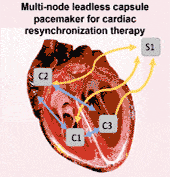
The increase in functional sophistication and complexity of implantable medical devices has resulted in the need for facilitating communication between one implanted device and another and/or external devices such as monitoring device and programming console. But, propagation of radio-frequency (RF) signals inside human body for communication is demanding to analyse as it is a highly complex medium consisting of different frequency-dependent lossy materials of varying thickness. Moreover, experimental analyses are also unfeasible because that requires probes to be placed inside a human body to collect the signals.
This study focuses on in-body to in-body implant communication for future multi-nodal capsule-like leadless cardiac pacemaker technology. The frequency range of 0.3 – 3 GHz is analysed using very detailed numerical simulations of digital human models. The results show that the Industrial, Scientific, and Medical (ISM) radio band of the frequency range of 2.4 – 2.5 GHz is optimal, having the least attenuation of signals considering the size constraints of the implant antenna.
Furthermore, the placement of an additional sub-cutaneous implant transceiver is studied. The analysis shows that the abdominal wall is the optimal position for the placement of the implant compared to shoulder and lateral side of the body. This result is further validated by an in-vivo experiment on an adult pig. The other novelty of the study is the investigation of the channel behaviour based on ventricular blood volume of the heart to find out the appropriate timing of the transmission of signals between the implants. The results show that the attenuation of the signal increases with the increase in cardiac blood volume.
The overall study would facilitate the design of a complete prototype of the multi-node leadless capsule pacemaker technology in the future.

